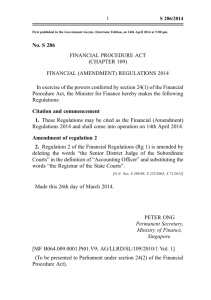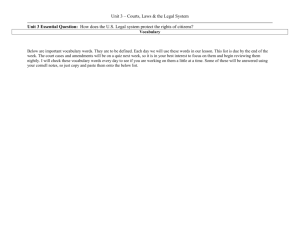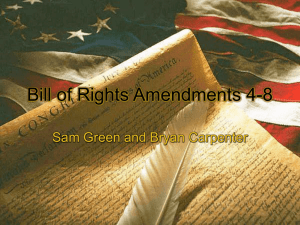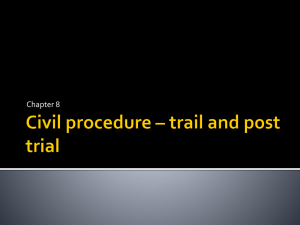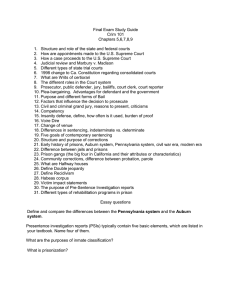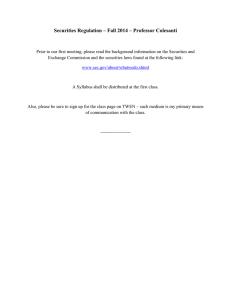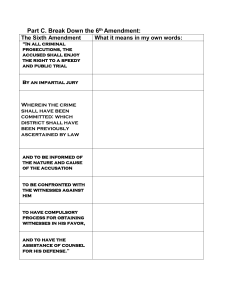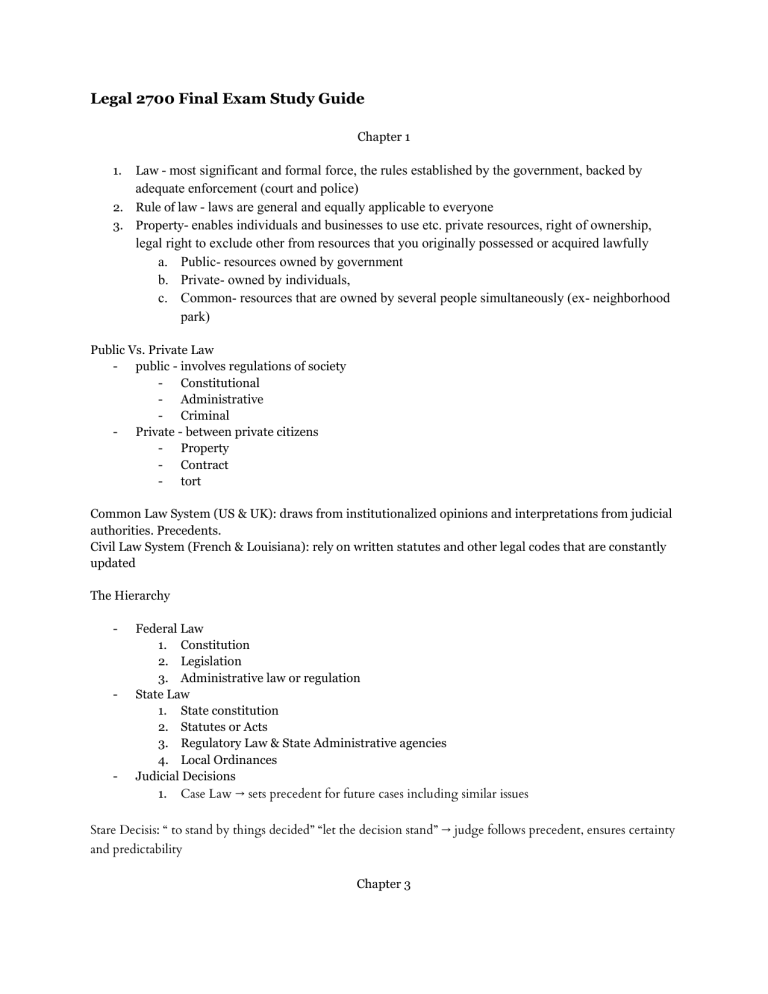
Legal 2700 Final Exam Study Guide Chapter 1 1. Law - most significant and formal force, the rules established by the government, backed by adequate enforcement (court and police) 2. Rule of law - laws are general and equally applicable to everyone 3. Property- enables individuals and businesses to use etc. private resources, right of ownership, legal right to exclude other from resources that you originally possessed or acquired lawfully a. Public- resources owned by government b. Private- owned by individuals, c. Common- resources that are owned by several people simultaneously (ex- neighborhood park) Public Vs. Private Law - public - involves regulations of society - Constitutional - Administrative - Criminal - Private - between private citizens - Property - Contract - tort Common Law System (US & UK): draws from institutionalized opinions and interpretations from judicial authorities. Precedents. Civil Law System (French & Louisiana): rely on written statutes and other legal codes that are constantly updated The Hierarchy - - - Federal Law 1. Constitution 2. Legislation 3. Administrative law or regulation State Law 1. State constitution 2. Statutes or Acts 3. Regulatory Law & State Administrative agencies 4. Local Ordinances Judicial Decisions 1. Case Law → sets precedent for future cases including similar issues Stare Decisis: “ to stand by things decided” “let the decision stand” → judge follows precedent, ensures certainty and predictability Chapter 3 Judges determine law Juries determine facts applied to the law Justices- At highest court level jurisdiction (appellate- reviewing court) MOST CASES ARE SETTLED BEFORE TRIAL Petit jury- Trial jury that acts as finder of fact and returns a verdict in criminal and civil cases - Decisions must be unanimous (some states have moved away from this) Decide guilt or innocence Grand Jury- only are paneled to help the prosecution to see if there is enough evidence to indict the defense Lawyers are counselors, advocates, and public servants Organization of the court System 1. Supreme (in NY highest is court of appeals) a. The supreme court is NOT always the highest court in the state 2. Appellate (court of appeals or circuit court) 3. Trial Subject matter jurisdiction- power over the issues involved in the case; can be limited to a subject matter or area in which parties live Supreme Court- 7-9 justices Intermediate (reviewing courts)- 3-5 justices Trial court- 1 judge 1. Trial courts,, lower wants facts to apply to law 2. Appellate courts, evaluate questions of law and refere factual laws to trial court and jury decisions ,was there an error of law? Whether law was applied correctly GA state business court- judge walt davis, started in august 2020, complex business disputes a. Needed this for complex business litigation b. Like the Delaware Court of Chancery Federal Jurisdiction 1. Questions of federal law 2. US is a party 3. State disagreements (case between states) 4. Suits between citizens of different states ($75,000 or more) Georgia has 3 federal district courts Power Of Judicial Review - Judicial review: ultimate power of invalidate actions by the president or the congress - Judicial restraint: power should not be used except in the unusual cases - Judicial activism: power should be used when the needs of the society justify its use Severability: if the clause in the legislation is so essential then it cannot be cut out to save the rest of the law Commerce clause-- usually always win, congress power, lead with this Chapter 4 Standing to sue- Plaintiff establishing that he or she is entitled to have the court decide the dispute Personal jurisdiction- Having authority over the parties to the case on the part of the court Long-arm statutes: provision for the service of process beyond the boundaries of the state ○ 1. Has committed a tort within the state. ○ 2. Owns property within the state that is the subject matter of the lawsuit. ○ 3. Has entered into a contract within the state or transacted the business that is the subject matter of the lawsuit within the state Class action suits- One or more plaintiffs file suit on their own behalf and on behalf of all other persons who may have a similar claim WHEN A PLAINTIFF FILES, THE LAWSUIT OFFICIALLY STARTS Methods to discovery • Interrogatories: Series Of Written Questions presented to the opposing parties; cheap; and sometimes get delivered with the complaint; have to be answered by the party receiving them within 30 days • Request For Production Of Documents:Either party asking the other to produce specific documents • Depositions:Lawyer Orally Asks Questions Of The possible witness; expensive but can be worth it; some people have bigger egos that get into the way of the deposition; has to be recorded by a court reporter • Request for admission:Requesting The Other party to admit that certain issues presented in the pleadings are no longer in dispute. Peremptory challenge: No cause or reason needs to be given to excuse a prospective juror - Cannot use these for racial or gender discrimination Burden of Proof - Civil Cases: “beyond a reasonable doubt” Criminal Cases: “preponderance of the evidence”, “clear and convincing proof” (highest level of burden) Deciding the Case - Main job of the jury is to determine the facts of the case and apply the law to those facts as instructed by the judge - Verdict- decision by the jury announced in courtroom - Judgement- judge deciding whether to accept the verdict or not - JNOV- asking the judge to set aside the jury’s verdict (saying their off the rails) - rarely ever granted - only used in civil cases- but we don't like to circumvent the jury - make a claim that the judge has a wack judgement of the law and they want a new trial Res Judicata (“its decided”) : Decision of the court is final and conclusive on all issues between the parties Chapter 6 The Constitution → 7 Articles and 27 Amendments Seperation of Power: - Federalism is the separation of powers between the federal and local state - Federal govt recognizes that states and sovereignty - State govt’s may not limit the federal govt’s exercise of power Supremacy Clause: FED OVER STATE 1. Constitution is supreme over all laws 2. Federal law is supreme over states laws 3. Preemption → higher law displaces lower law if in conflict 4. State law is invalide is it conflicts with federal law Commerce Law - Provides federal government the power to regulate business - Regulation of foreign commerce (total and exclusive) - State and local governments may regulate such activities if they are conducted entirely within the state’s boundaries - Regulation of interstate commerce - States cannot impede interstate commerce as decided by the Supreme Court - court created a new test- if there is a huge economic effect or will create a huge economic effect then congress can step in and take control Contract Clause - States cannot enact laws that impact rights and duties under existing contracts - Does not apply to federal government - State laws passed during emergency situations can be approved Police powers - State and local government authority to regulate business stems from “police powers.” Dormant commerce clause- prohibited laws to interfere with interstate commerce Amendments and Basic Provisions - Basic constitutional rights are not absolute - Depends on the nature competing public policy - Guarantees exist to protect the minority from the majority - Constitutional rights vary from time to time First Amendment - Freedom of religion - Establishment clause- congress shall make no law respecting or establishing a country wide religion; cannot force someone to be a certain religion - - - Free exercise clause- cannot ban anyone from being a certain religion Freedom of speech- covers written and verbal communication and symbolic speech - Unprotected Speech (from freedom of speech in constitution) 1. Fighting words 2. Obscenity 3. Defamation 4. Clear and Present Danger 5. False advertising Commercial speech - freedom of speech protects corporations and individuals Freedom of press - The press is the only organized private business given explicit constitutional protection - Construed to prohibit prior restraints on publications - Libel is used to recover damages as a result of printed defamation of character Second Amendment - One’s right to possess guns Fifth Amendment: Eminent Danger (takings clause) - Allows the government to take private property for public use after paying just compensation Kelo v. City of New London Connecticut (2005) - Whether corporation in taking property from private owners for the purpose of economic development satisfies the public use requirement for the 5th amendment - Verdict: did not violate 5th amendment, private build benefit the overall public Fourteenth Amendment: No state shall make or enforce any laws that 1. Abridge privileges or immunities as citizens of the US 2. Deprive any persons of life, liberty, or property without due process of law 3. Deny any person within its jurisdiction the equal protection of the laws Equal Protection (can a law discriminate) - Minimum scrutiny - rationally connected to a permissible or legitimate government objective - Presumed valid: height, weight, age, testing school desegregation, veteran’s preference, marriage - Strict scrutiny - necessary to a compelling state interest - Suspect Classes- race, national origin, legitimacy - Fundamental right: to vote, to travel, to appeal - Quasi-strict scrutiny - substantially related to an important government interest - Quasi-suspect classes: gender Chapter 7 Property is the legal right to exclude others from resources that are originally possessed or are acquired without force, theft, or fraud - Property rights are absolute but not infinite (constitutional rights are not absolute) - Absolute means that you can seek out police or legal courts to protect or you cannot - Not infinite means uses protected by the legal fence do not go on forever Divisions of property 1. Real Property - land and interests in land 2. Personal Property - all moveable resources - Tangible - Intangible - intellectual property (copyright, patent) Property Boundaries 1. Air rights- you own the air as long as you can connect it to your property 2. Subsurface rights- landowner also owns all minerals, gasses and oils beneath the surface of the land 3. Fixtures on land- an object of personal property that has become an object of real property a. Physical attachment b. Closely associated with the use to which the land is put (unless stated in the contract otherwise) Types of Ownership→ Fee simple: represents the maximum estate allowed under the law - Fee simple absolute- involves no limitations or conditions attached - Fee simple defeasible - may have a condition attached to its transfer Life Estate: grants ownership in land for the lifetime of a specified purpose - Present interest - Remainder interest - future interest waiting on the present interest to expire Leasehold Estate: property rights granted to tenants by a landlord Concurrent ownership: more than one person can own the same property (share the entire resource) - Tenancy in common- many people - Joint tenancy - 50/50 , right of survivorship (the other party gets all of the property if the other person dies) Special Applications of Property → Easement: right to cross over land - Easement by reservation -sells land but reserves and easement - Natural easement - get from land to nearest road - Negative easement - adjoining landowner can’t negatively affect your property - Easement by prescription - wrongfully, openly crossing land for 20+ years; earns the right to cross the land legally after the set number of years; does NOT mean they own it - Utility easement - areas of property for utility companies Bailments: good placed in another's possession to be returned in the future (bailor=owner, bailee= possessor) NOT a transfer of ownership Burden of proof is on the bailee, law presumes that the bailee has breached duty of care when the item is not returned in proper condition Lost V. Mislaid Items - Lost- unintentionally left by the owner; finder’s keepers - Mislaid- person intentionally put something somewhere with the intent to return to it but forgot to pick it up Adverse Possession: provides ownership of land under state statute when possession is… Intent is not a factor - Open and notorious - Contiguous - For a prescribed period of time - Actual and exclusive - Wrongful Doctrine of Confusion: illustrates importance of boundaries to the concept of property - Occurs when (fungible) identical goods get mixed together - Have to determine if it was innocent or nefarious Title: Ownership represented by a physical document registered with the state for certain resources Deed: document of title that transfers ownership of land - Warranty deed- guarantees the grantor has a right to sell and claim - Special Warranty deed- warrants only against anything occurred during their physical ownership - Quitclaim deed- transfers ownership with no promises at all about owners title Security Interests (mortgages, deeds of trust, land sales contract and secured transactions)→ Recording statutes → mortgages and deeds of trust must be registered in a recording office → provide notice of the security interest to potential buyers and lenders of land Article 9 of Uniform Commercial Code: set of laws that controls security interests Have to attach and perfect security interest: - Attachment- Secured party holds given value , Debtor owns the collateral, Security agreement is provided (must be in writing, signed by debtor, and must have description of collateral) - - Perfection- Arises When Security Interest Is attached and creditor has taken all proper steps required by Article 9 Artisan’s Liens & Mechanic’s Liens - line cutters Chapter 8 Sources of Contract Law - Legislation: Uniform commercial code (article 2), contracts for goods - Common law- judges’ decisions; contracts other than goods (NDA) Classifications of Contracts - Bilaterals and unilateral contracts - Bilateral- two promises (mutual) - Unilateral- one promise seeking the performance of an action - Express and implied-in-fact - Express- written or orally given contract - Implied in fact- no express terms either oral or written but contract based on their conduct - Implied-in-law or quasi-contracts - Neither party intended on the contract but one party was unduly benefited and the other party can use this form of contract to get the benefit back (no actual contract) - Ex- overpayment Contractual Performance Terminology: - Executed Contract -parties have performed their promises - Executory Contract -parties have not performed their promises Requirements for an Enforceable Contract: 1. Offer to enter a contract 2. Acceptance of the offer 3. Consideration for each promise 4. Capacity of each party to enter into a binding agreement 5. Legality of subject matter How can you terminate an offer? **must do before the offeree accept the offer 1. Revocation by the offeror - the offerer takes back the offer 2. Rejection by the offeree - the offeree does not accept the offer 3. Counteroffer - when a person rejects the offer, you can reoffer with different terms 4. Lapse of time - the offeree does not accept within deadline or reasonable time period Automatic offer termination 1. Subject matter destruction- when the object of the contract is destroyed or legally eliminated 2. Offeror death or insanity- when the offeror no longer has the capacity to make the offer 3. Subject matter illegality- when a change in the law renders the agreement illegal, acceptance is no longer possible Acceptance - Mirror Image Rule: the acceptance must match the offer exactly (if not, it's a counter offer) - Mailbox Rule: acceptance becomes legally binding when placed in mail Consideration - Receipt of a legal benefit of the suffering of a legal detriment - Option contract-- firm offer (exception); in the sale of good, the offeror must keep the contract open for no more than 3 months without any consideration - Accord and satisfaction- if you are offered a settlement and take it, you give up the right to sue Promissory Estoppel - The doctrine states that a party who reasonably relies on a gratuitous promise can ask a judge to award compensation for that reliance Capacity- one’s ability to be bound by a contract - Minors- cannot be legally bound to contractual promises with, can disaffirm contract and legally recover any consideration to the other party. Once 18, contracts ratify and they lose ability to disaffirm contracts. Intoxicated or Mentally Incompetent Persons- contracts are voidable depending on the person’s capacity to understand the contract’s nature and purpose Commercial speech - Freedom of speech protects corporations and individuals - Protects the listener and the speaker - Not as extensive as individual rights - Government can limit commercial speech and when a state interest is at stake Oral contracts- generally as enforceable as written contracts if meeting the requirements for a contract - Statute of Frauds - Legal requirement that certain contracts be in writing - Business contracts required in writing - Exception to Writing Requirement: - Part performance - creates an exception that the sale of land must be in writing, When a buyer of land has made valuable improvements in it, or when the buyer is in possession of it and has paid part of the purchase price, even an oral contract to sell is enforceable - Rules involving goods- specifically manufactured goods= buyer places custom order over 500 and seller begins to produce than they can enforce a oral contract - Judicial admission - If there is a judicial admission, the statute of fraud-based defense disappears. The judge proceeds to decide whether the oral contract is valid and enforceable Chapter 9 Rules of Interpretation: Handwritten terms → typed terms → preprinted terms Parol Evidence Rule - Prohibits testimony about the oral negotiation that results in a written contract - Applies to evidence of oral agreements made at the time of or prior to the written contracts - Exception allows evidence of oral agreement that explains the meaning of written terms without changing the terms Performance - Duty of performance: performance required by the other party as promised in the contract - Discharged: occurs when the party is relieved from other further responsibilities of performance Conditions of Performance - Condition precedent: if something must take place in the future, before a party has a duty to perform - Condition subsequent: excuses contractual performance of somes future event takes place Levels of Performance 1. Complete performance - complete payment for service 2. Substantial performance - attempt to fully perform, but has fallen short; remedies for damages 3. Material breach - performance below what has been previously promised to complete Excuses for Nonperformance - Impossibility of performance - Commercial impracticability - Waiver (party intentionally relinquishes right to performance) - Release (party announces the other does not have to perform) Rescission: equitable remedy which allows a contractual party to cancel the contract - requires each party to return the consideration given the other. Often used in fraud misrepresentation or mistake cases. May be coupled with restitution which requires a party to compensate for something that cannot be returned Injunction: court order for a party to do something or refrain from doing something, often employed when a license to property or intellectual property is at issues Efficient Breach- one party purposefully breaches the contract and pays out the monetary compensation because they do the numbers and figure that they will be in a better position if they just breach it and pay the remedies instead of doing what they promised Specific performance- court ordered remedy when subject matter of the contract is unique; parties are compelled to perform their promised actions Third Parties rights: - Beneficiaries - One or more of the original parties in a contract may intend for the contract to benefit a third party - The beneficiary can sue for damages if they were intended to receive benefits from a contract - Assignment of contracts - the transfer/ sale of rights under a contract. Assignor assigns rights of contract to assignee - Novations - three or more parties are in the contract and agrees to relieve the obligor from liability by substituting the assignee in their place Chapter 10 Categories of Torts 1. Intentional - deliberate action that caused injury 2. Negligent - some sort of injury because they failed to act reasonably 3. Strict liability - did not act negligently or intentionally but some act that you took caused damages and you are strictly liable for it Intentional Torts: - Assault - placing another in the immediate apprehension that they are about to be harmed - Battery - Illegal touching without the person’s consent - Infliction of mental illness - Battery to the emotions - - Has to prove that the conduct that has happened was so extreme that it was outside of the scope of everything and caused damages Invasion of privacy - misappropriation of name or likeness, intrusion or physical solitude, public disclosure of highly objectionable, private information Defamation - something said about someone else that it meant to hurt their reputation Invasion of Privacy: 3 types of invasion of personal interest 1. Misappropriation of name and likeness- if you use anyone’s picture or likeness or name, you MUST have their release and consent 2. Intrusion on physical solitude- cannot search through people’s personal stuff; cannot tap into phone calls; wire someone 3. Public disclosure of highly objectionable private information - even if it's true, can still be an invasion of privacy Defamation - Slander- oral defamation - Libel- written or published over radio/television Negligence: what's clogging up the courts Elements you have to prove1. Duty of care- general duty on all of us to act reasonable; presumed that the ordinary, reasonable person would act reasonably to take precautions for an event that you can foresee 2. Breach of duty - acting unreasonably behavior; you can be vicariously liable (like if your employee is on an errand for you and they commit a crime- you are liable too) 3. Causation in fact - (actual cause) Before a person is liable to another for negligent injury, the person’s failure to use reasonable care must actually have “caused” the injury 4. Proximate causation - (legal cause)- the proposition that those engaged in activity are legally liable only for the foreseeable risk that they cause 5. Actual injury Res Ipsa Loquitur- “the thing speaks for itself”, sponge in patients body after surgery Defenses to Negligence: States decide this - Contributory negligence -plaintiff contributed to injury even 1% - Comparative negligence - compares fault based on % (can be partial and pure) Assumption of risk - plaintiff knowing and willingingly undertaking danger Strict Liability in Tort - Injury causing behavior that is neither intentional nor negligent - Ex: 2 main - Strict products liability - Production defects - Not created to standards- mistakes in the production process - Design defects - when a product is manufactured according to the manufacturer’s standards, but the product injures a user due to its unsafe design - Ultrahazardous activity - Keeping dangerous animal as a pet or explosives Dram Shop Acts - strict liabilities on bar owners, you are responsible for damages caused by those who you serve Compensatory damages- compensate plaintiff for injuries suffered Punitive Damages: awarded by courts to punish defendants Chapter 13 Malum in se VS Malum Prohibitum - Malum in se- evil in of itself - Ex: murder, rape - Malum prohibitum- unlawful based on society standards - Ex: speeding, drugs White‐ collar crime: Any illegal offense that occurs in a business or professional setting Classification of Crimes - Felonies: punishable by fine or imprisonment in a penitentiary for a period of one year or more (commenced with a grand jury indictment) - Misdemeanor: punishable by a fine or jail sentence of less than 1 year (commenced with the government issuing an information) Pleas to Criminal Cases - Guilty - Not guilty - Nolo Contendere “no contest” (can’t be used in civil) - Allows for the judge to sentence you as if you plead guilty but in civil court, the opposite party has to build their case from the ground up and cannot use the result of the criminal case to get damages 4th Amendment - Protect individuals and corporations from unreasonable searches and seizures by the government - Requires the police to obtain a search warrant - Exceptions: - Warrantless inspection - Search incident to arrest - Exigent circumstances - Highly regulated business Ex: RIley V. California → cell phone during an arrest is unconstitutional 5th Amendment - protects accused from testifying against themselves Does NOT protect - Being required to product physical evidence - Producing business records - Corporations (exception sole proprietorship because they cannot separate the person from the business entity) Individuals cannot be tried twice in the same governmental entity, except if in two different courts like civil and criminal or state and fed→ “double jeopardy” Miranda rights (6th Amendment)→ mere silence is not enough! 6th Amendment - Speedy and public trial - Trial by jury - Be informed of the charge against oneself - Confront the accuser - Subpoena witnesses in one’s favor - Have the assistance of an attorney (only when incarceration is a possible punishment) 8th Amendment - Prohibits the federal government from imposing excessive bail, excessive fines, and cruel and unusual punishment. Death penalty should not be applied to anyone who was under 18 years old at the time the crime was committed and to anyone who is mentally handicapped. Crimes: Obstruction of Justice→ destroying evidence Larceny→ - Robbery - stealing with force - Burglary -stealing in general Embezzlement → fraudulent appropriation of property that was entrusted to you Chapter 11 Trade Secret- any form of knowledge that is kept secret (reasonable measures taken to keep it secret- only way to get it would be misappropriation) and has economic value Misappropriation- when one improperly acquires or discloses secret information - Exceptions: - Independent creation- happened to create the exact information on their own - Reverse engineering- have the final product and worked backwards unless it was specifically defined in a contract not to do this Patent law- new invention→ legal monopoly-exclusive right created by statute and conveyed by the PTO Utility-20 yrs Design (appearance) -15 yrs Plant- 20 yrs Patents have to have: - Novelty- Something new and different from the prior art - Nonobviousness- Ability of an invention to produce surprising or unexpected results - Utility- must do something useful Defenses: - Challenge the validity of the patent - can claim that the patent wasn’t valid if it does not meet these criteria: - 1. shown by other evidence that the invention was disclosed to the public in some way before the application for the patent - 2. not subject matter that can be Marks are protected by the Lanham Act of 1946 1. Trademark - any mark, word, picture or design attached to a good to indicate their source; designated by the superscript TM and by the circle R of its registered 2. Service mark - mark that is used in advertising service; SM superscript 3. Certification mark - not used by the the owner; guarantees that the product that has this certification is kept up to standards; meant to be used by other people 4. Collective mark - not meant to be used by other people; only can be used by particular members of the organization 5. Trade dress - the certain total visual image that defines a good or service *color and soundmarks also but they try not to give out a lot ot these → trademarks don't want to become generic because then they can lose their marks Trademark registration - Pto places in official gazette (tells all mark owners that you are seeking ownership) - Registered in the principal register (then it is official) - Trademarks have unlimited lives- have to tell the PTO every 6 years that the trademark is still in use and every 10 years to renew - If acquires a secondary meaning→ listed on supplemental register for five years a name or descriptive terms can acquire full trademarks (honeybaked ham) Trademark enforcement - - infringement - civil violation of a trademark Federal Trademark Dilution Act, 1995- Prohibits the usage of a mark same as or similar to another’s trademark to dilute its significance, reputation, and goodwill (only famous marks) - Types: - Blurring ‐ When usage of a mark blurs distinctiveness of a famous mark - Tarnishment ‐ When usage of a mark creates a negative impression about the famous company Defenses: - Mark is not distinctive - Fair use: any sort of discussion (media), criticism, parodies or educational purposes - Mark is generic Copyrights - Criteria for copyright protection: - Work must be original Must be fixed in a tangible medium of expression (books, hard drive, etc.) Must show creative expression (mere effort isn't enough; not just an idea) - As of January 1, 2021, anything published in 1925 or before is released to the public domain Chapter 14 Chapter 15 Administrative Agencies- Boards, bureaus, commissions, and organizations that make up the governmental bureaucracy ○ ○ – Quasi‐ legislative- agencies have the ability to issue rules and regulations (preempt state laws) – Quasi‐ judicial- they make decisions like a court; binding decisions 5-7 members approved by the senate- no more than the simple majority may be of the same political party ALJ- administrative law judges Chapter 17 Securities- Any interest or instrument that offers the right to subscribe to or purchase stock, bond, or any certificate of interest Securities and Exchange Commission (SEC) ● Responsible for administering the federal securities laws ○ 5 commissioners appointed by the president ● Consists of five commissioners ○ non-partisan ○ No more than 3 commissioners can belong to the same party ● Possess quasi‐ legislative (it has adopted rules and regulations relating to financial and other information that must be furnished to the Commission) and quasi‐ judicial powers (the SEC also is involved in a variety of investigations) ● Laws come in waves (like a roller coaster) Securities Act of 1933 - Requires the disclosure of information to the potential investors Applies to the initial sale of the security Documents involved: - - Registration statement- detailed disclosure of financial info, essential facts, description of properties, what do they own; info about the management of the company Prospectus: set forth the key information contained in a company’s registration statement Periods: - Pre Filing period- not registered with the SEC; prohibited to sell covered securities during this period but allowed to engage in preliminary negotiations and agreements with underwriters - Waiting period- after registration is filed with the SEC, the SEC is determining whether they should admit the sale of your security; cannot sell any securities under the act but you can seek a buyer or solicit a sale but you can’t consummate an offer yet; solicitation takes place with tombstone ads (These ads are brief announcements identifying the security and stating its price, by whom orders will be executed, and from whom a prospectus may be obtained) - Post Effective period (usually 20 days)- registration becomes effective at the end of the waiting period; don’t want to delay the waiting period; securities can be sold Securities Exchange Act of 1934 - - Section 10(b) and Rule 10b-5: Anti Fraud Provisions - The concept of fraud under Section 10(b) encompasses not only untrue statements of material facts but also the failure to state material facts necessary to prevent statements actually made from being misleading. (half truths are also fraudulent) - failure to correct a misleading impression left by statements already made, or silence where there is a duty to speak, gives rise to a violation of Rule 10b-5 because it is a form of aiding and abetting the deception. Insider trading- illegal when a person trades a security when in possession Tipper-Tippee Liability - Tippee: the person who receives material non-public information from a tipper - Tipper: a person who discloses material nonpublic information to another person Private Securities Litigation Reform Act (PSLRA) of 1995 - Limits frivolous lawsuits, before this law plaintiffs would file lots of securities lawsuits against companies (fishing for suits), limits damages that plaintiffs could recover Tried to make lawsuits a little more fair for corporations State Blue Sky Laws- probably because they were intended to protect the potential investor from buying “a piece of the attractive blue sky” (worthless or risky securities) without financial and other information about what was being purchased - Uniform Securities Act, 1956- provides a model for the blue sky laws Sarbanes-Oxley Act (SOX) of 2002 ● Primary purpose is to ensure the accuracy and integrity in the financial reporting of public companies ● Create PCAOB (given oversight of accounting firms that audit public companies.) ○ requires that auditing firms refrain from conducting a variety of nonauditing services. These services include bookkeeping, system designs and implementation, appraisals and valuations, actuarial services, human resources functions, and investment banking ● Auditing and consulting can never be in the same company Dodd-Frank Wall Street Reform and Consumer Protection Act of 2010 ● ● ● Up the ante on whistleblower incentives- if you whistle blow and it's right, you get a bounty (percentage of the recovery) Address Many Issues Of Financial Reform Congress Authorized The Creation Of New administrative agencies to achieve the goals of Dodd‐ Frank Act ○ Financial Stability Oversight Council (FSOC) - trying to avoid taxpayer bailout ○ Federal Insurance Office (FIO) ○ Office of Housing Counseling (HUD) ○ Office of Credit Ratings (SEC) ○ Investment Advisory Committee (SEC) ○ Office of Investor Advocate (SEC) Jumpstart Our Business Startups (JOBS) Act of 2012 ● ● ● Goals ○ Ease burdensome federal regulations ○ Allow individuals to invest in start‐ ups through relaxed rules (for some IPOs) Title II ○ Allows companies to advertise that they are seeking investments from accredited investors (those with $1 million in assets or annual income of more than $200,000) Title III ○ ○ ○ ○ Allows a company to raise up to $1 million by selling securities Crowdfunding - raise money even through non accredited investors (raise small amounts of investment dollars from many people, using the Internet to spread the investment opportunity) Anne and Josie Notes From Lecture Public law: -constitutional -criminal US constitution State constitution Local ordinances Case law Trial court- 1 judge Court of appeals- 3-5 judges Supreme court- 7-9 Supreme court is NOT the highest court in every state - Ex new york the court of appeals is the highest one Georgia has 3 federal district courts Writ of certiorari- needs 4 scotus judges to appeal Questions of law- appellate level Petty jury- in both civil and criminal cases and decide the verdict Grand jury- just criminal cases to say if there is enough evidence for a case 4 ways into the federal courts 1. Federal question 2. Diversity of citizenship a. Cases that are $75,000 or more 3. US is a party 4. The states are fighting Commerce clause- superpower of congress Long arm statute- allows states to reach across states line as long as they have minimum contacts Government files a claim against the defendant for a criminal case MOST cases settle before they reach actual trial Discovery: 1. interrogatory - least expensive; just a list of questions 2. Dofe 3. Dhjdsj Default judgement- if you don't show up to court or answer within 30 days; the defendant gets their reasonable claim Statute of limitations- limit time to file claim Courts must always have subject matter and personal jurisdiction, plaintiff must have standing JNOV- the judges make a different decision than the jury Strikes for cause- prosecution can strike people from the jury without any reason (only have a few per case); but can’t strike based on gender or race Clear and convincing proof- most substantial and strictest one Jury renders a verdict Judge renders a judgement Supremacy clause- federal law is supreme (federal law preempts state law) Contract clause- only applies to states Constitutional rights are NOT absolute - Categories of unprotected speech - Defamation - False and deceptive advertising - Inciting violence - Fighting words - 5th amendment: Takings clause (eminent domain)- can take your land with compensation - 14th amendment- equal protection clause- don’t treat people differently without a good cause Discrimination can be legal if it passes strict scrutiny- race, age - Quasi-strict scrutiny- gender Fee simple absolute Tenants in common Joint tenants with rights of survivorship Quit claim deed Warranty deed Life estate- present interest Easement by prescription- just a right to traverse or access the property; Hilton Head lady who let people openly, wrongly cross her property to get to the beach and so they earned the right to cross it without interference Adverse possession- , notorious, wrongly, openly be on a piece of property for a prescribed period of time; then you legally own the land and can have your name on the deed Loss vs mislaid- determined by circumstances by which it was found - lost - who found it - Mislaid- kept it possession of premises owner Have to attach to the debtor and perfect the Warrant requirement Self incrimination- (sole proprietorship is the only business that can claim this) Double jeopardy- cannot be tried by the same governmental entity for the same crime Does not count if you are tried by the state and federal courts Only have the right to attorney when incarceration is a possible punishment Guilty Not guilty Nolo contendere- not available everywhere, can save you if you are going to be charged twice Most common way to acquire resources- idea of exchange - Offer - Acceptance must mirror offer exactly to be valid - Acceptance Bilateral- promise for promise Unilateral- promise seeking action in return Express- oral/written Implied in fact- formed in conduct Implied in law- one party has been unjustly enriched at the expense of the other party Executed- promise has been performed Executory- have not performed your promise yet Condition precedent- has to be done before the promise can be done Injunction- refrain from activities order from court Waiver and release- after you’ve breached Release- before the breach Third party rights for contracts- only if they are intended third party (creditor or beneficiary) - No reward if not intended Efficient breach- you breach the contract because paying out the breached thing is better than actually performing the promise Novations Oral contracts are fine as long as they meet the 5 requirements for a valid contracts Statute of frauds- has to be written in order to be accepted by the court Termination of a contract Consideration- skin in the game; both people want something Option contract- have to give them consideration (usually money) in order for them to keep the contract open Firm offer contract- in sale of goods; the seller has the keep the contract open for no more than 3 months without any consideration Promissory estoppel- michael in the office with scotts tots; agreed to do something and the people reasonably assumed that this would occur so they relied on it; the promising party has to follow through Handwritten terms will trump typed words Tort- Negligence- duty was breached, proximate cause, injury - Most number of lawsuits - Res se loquitur- thing speaks for itself (sponge left in body) - Defenses: assumption of the risk, - Contributory negligence - if the plaintiff is even 1% at fault then the case is thrown out - Partial - as long as the plaintiff is less than 50% negligent then the case can occur and their percentage of guilt is subtracted off of the damages - Pure - whatever % negligent the plaintiff is subtracted off the damages against the defendant - Intentional- intent - Assault, battery, invasion of privacy, defamation - Strict liability Patents protect inventive act, has limited protection - Lanham act of 1946 If your mark becomes generic, you lose your right to make money off of it Closely held v publicly held businesses Sole proprietorship Partnership- jointly and severally liable Corporations (domestic, foreign, alien) S corporations- persons of a corporations are treated as partners for tax purposes LLC- organizers form Piercing the corporate veil- alli case, government allowed to go after their personal accounts even though the corporation was responsible ALJ- administrative law judges Federal register- published with proposed orders and published orders Exhaustion of remedies Congress has delegated authority to administrative agencies so the courts have a very limited scope when reviewing cases in the administrative agencies and usually rile in favor of them State securities blue sky laws- federal law does NOT preempt the state law in this case Title 7- 15 or more employees Retaliation act- just benign a witness to someone’s case and your employer messes with you FMLA

